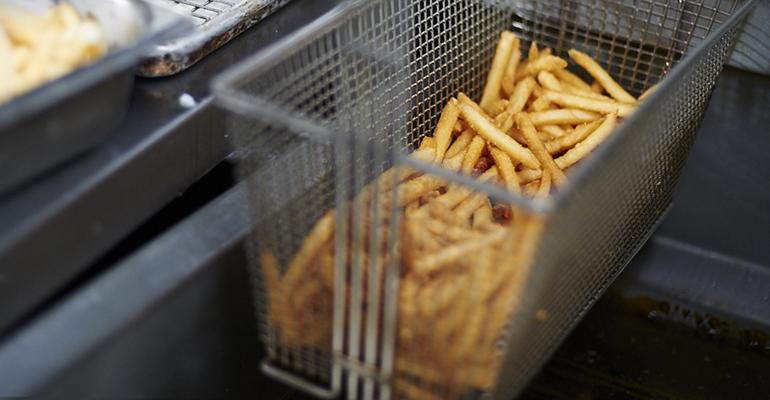Sponsored by QUALISOY
With the U.S. Food and Drug Administration’s (FDA) May 2017 menu labeling deadline in effect, chefs are looking to high oleic soybean oil – a highly stable oil that contributes 0 grams trans fat – to meet food quality and taste expectations.
The best part? There’s no compromising flavor or functionality. In fact, both improve. High oleic soybean oil’s neutral flavor profile allows recipes’ star ingredients to shine. Its high stability results in longer fry life, cleaner equipment and lower costs. High oleic soybean oil is ideal for a multitude of applications including high heat frying and sautéing. It’s also perfect for use in baked goods and snack foods.
Beyond impressive performance, high oleic soybean oil is 100 percent U.S.-grown, allowing restaurants to support U.S. farmers and source from a sustainable and stable supply chain.
Heightened Food Quality and Connection to Local Agriculture for Purdue University
Purdue University, located in the heart of the high oleic soybean growing region in West Lafayette, Indiana, began testing high oleic soybean oil in place of its current cooking oil, canola, in March 2016. The university feeds up to 22,000 students a day across five dining courts.
“As an Indiana soybean producer, this is the ultimate farm-to-fork initiative,” said Mike Beard, a United Soybean Board Farmer-Director from Indiana.
The high oleic soybeans were grown and processed within the state.
Purdue Dining & Catering partnered with QUALISOY® – an independent, third-party collaboration among the soybean industry that serves as a resource for the latest enhanced soybean traits – and worked with Purdue’s College of Agriculture and College of Health & Human Sciences to test the oil daily. Graduate and undergraduate students in university labs gained real-world food science experience that will benefit their future careers.
The results were overwhelmingly positive.
“We’ve had students say [our fried chicken wings] taste better than going out to a restaurant. What we’ve seen with high oleic soybean oil is a lighter texture, a fresher look…the appeal to it has really been great,” said Greg Minner, Director of Dining & Catering at Purdue. “They feel like it’s less greasy when it comes to the French fries, and that they have a better taste profile.”
While local sourcing benefits chefs and students by connecting them to local agriculture, it also allows local farmers and producers to gain timely, direct feedback on their product.
“I love that tomorrow’s leaders are enjoying today’s high oleic soybean oil.” Mike Beard, USB Farmer-Director
Improved Product Nutrition
Restaurant patrons are more health-conscious than ever, especially when it comes to fat content. The United Soybean Board’s 25th annual Consumer Attitudes about Nutrition Study revealed that 71 percent of consumers are interested in the type of oil used in restaurants for frying and preparing foods. Most notably, nearly 6 out of 10 consumers said they would be more likely to eat in a restaurant that used an oil with a lower saturated fat content to fry or prepare food.
High oleic soybean oil contributes zero grams trans fat and is low in saturated fat. In addition, high oleic soybean oil delivers three times the amount of beneficial monounsaturated fatty acids (MUFAs) compared to conventional soybean oil, which may benefit heart health.
Longer Fry Life
QUALISOY conducted a fry study with Stratas Foods, LLC, to evaluate high oleic soybean oil’s functionality and performance in high heat applications. The study found that the oil’s oxidative stability index (OSI) yields values greater than 25 hours, greatly extending fry life. Its superior resistance to oxidation and reduced build-up of polymers on equipment in high heat applications means less oil wasted and less time maintaining equipment. Additionally, foods fried in high oleic soybean oil retain more moisture and absorb less oil, meaning chefs don’t have to top off the oil as often. This translates to greatly reduced annual costs for restaurants.
Stable in High Heat Applications, Stable in the Market
High oleic soybeans are on pace to be America’s fourth largest row crop by 2023. That means current domestic quantity is abundant and growing every year, ensuring worry-free, secure supply. The vast potential growing area for high oleic soybeans contributes to a more stable production volume from crop year to crop year. In addition, multiple and diverse crushing and refining facilities keep production closer to utilization, creating a shorter, more cost-effective and manageable supply chain. Most importantly, every dollar spent on high oleic soybean oil supports U.S. farmers and local economies.
Testing High Oleic Soybean Oil
High oleic soybean oil is available now for testing. There are sufficient supplies of oil available for low-volume-usage companies, with abundant quantities expected in the near future. Ultimately, high oleic soybean oil will be the food industry’s most dependable liquid high stability vegetable oil solution.
To request a free trial of U.S.-grown high oleic soybean oil, visit QUALISOY.com/samples.



